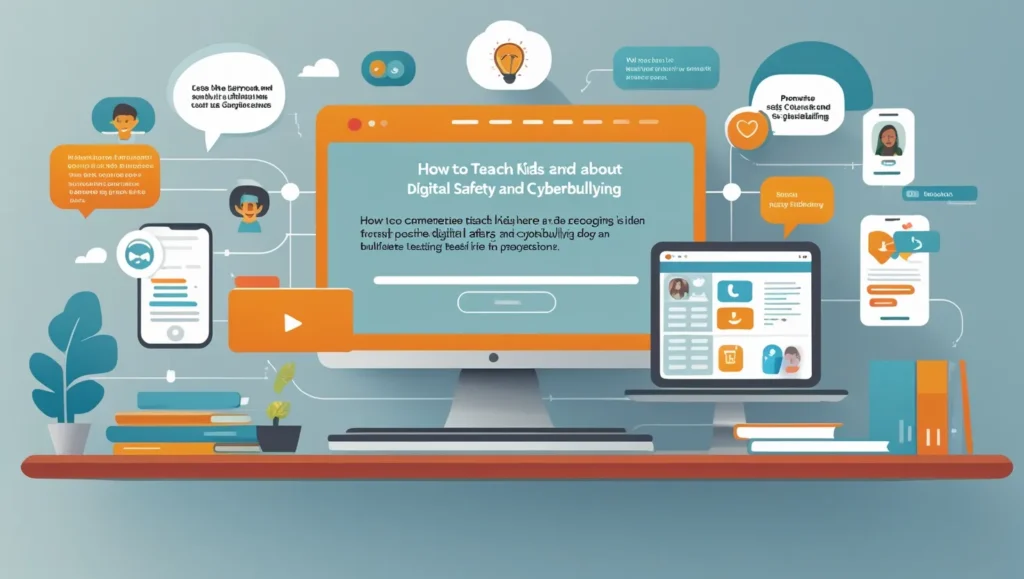Teach Kids About Digital Safety and Cyberbullying
In today’s digital era, children are growing up surrounded by technology. From social media platforms to educational apps, the internet has become an integral part of Teach Kids About Digital Safety and Cyberbullying their lives. While it offers numerous opportunities for learning and socializing, it also presents potential dangers such as cyberbullying, online predators, and privacy risks. As parents, educators, or guardians, it’s essential to equip children with the knowledge and skills to navigate the online world safely.
1. Start with Open Conversations
The first step in teaching kids about digital safety is to have open and honest discussions. Encourage children to share their online experiences and ask questions. Use real-life examples to explain the importance of protecting personal information and recognizing harmful behavior.
Tips for Conversation:
- Ask about their favorite websites, apps, and online games.
- Discuss what they should do if they encounter something uncomfortable.
- Emphasize that they can always talk to a trusted adult if they feel unsafe.
2. Explain the Concept of Cyberbullying
Cyberbullying involves using digital platforms to harass, threaten, or humiliate others. Unlike traditional bullying, it can happen 24/7 and reach a wider audience quickly. Help kids understand what cyberbullying looks like, including mean comments, Teach Kids About Digital Safety and Cyberbullying spreading rumors, or sharing private information without consent.
How to Spot Cyberbullying:
- Receiving repeated hurtful messages.
- Being excluded from online groups.
- Encountering fake profiles created to harm others.
3. Teach Safe Online Practices
Promoting responsible online behavior can significantly reduce the risk of cyber threats. Educate children on how to stay safe by following these guidelines:
- Use Strong Passwords: Encourage the use of complex passwords and not sharing them with others.
- Think Before Posting: Remind them that anything posted online can be permanent.
- Adjust Privacy Settings: Teach kids how to manage privacy settings on social media to control who can see their content.
- Be Wary of Strangers: Advise against accepting friend requests or chatting with people they don’t know.
4. Encourage Positive Online Behavior
Promote kindness and empathy in digital interactions. Encourage children to be responsible digital citizens by thinking before they post and treating others with respect.
Positive Online Behavior Tips:
- Compliment others and offer supportive comments.
- Report and block inappropriate content.
- Stand up against cyberbullying by supporting victims.
5. Monitor and Set Boundaries
While it’s important to respect a child’s privacy, parental supervision is necessary for ensuring safety. Establish clear rules about screen time, appropriate websites, and Teach Kids About Digital Safety and Cyberbullying online activities.
Suggestions for Monitoring:
- Use parental control apps and software.
- Regularly review their friend lists and online activity.
- Set time limits for device usage.
6. Teach Kids How to Respond to Cyberbullying
Empower children to handle cyberbullying situations effectively. Encourage them to stay calm, avoid retaliating, and follow these steps:
- Ignore and Block: Block the bully and avoid responding to negative messages.
- Save Evidence: Take screenshots as proof of the bullying behavior.
- Report the Abuse: Most social media platforms have options to report abusive content.
- Seek Support: Encourage children to talk to a parent, teacher, or counselor.
7. Build Digital Resilience
Developing digital resilience helps children cope with negative online experiences. Teach them to stay positive, manage their emotions, and seek help when needed.
Ways to Build Resilience:
- Engage in offline activities like sports, arts, and hobbies.
- Practice mindfulness and stress-relief techniques.
- Foster supportive friendships and family connections.
8. Lead by Example
Children often model the behavior they observe. Demonstrate positive digital habits by practicing mindful screen use, respecting privacy, and handling conflicts maturely.
Final Thoughts
Teaching kids about digital safety and cyberbullying is an ongoing process. By fostering open communication, encouraging responsible behavior, and providing Teach Kids About Digital Safety and Cyberbullying guidance, we can help children navigate the digital world safely and confidently. Empower them to make informed choices, stand up against cyberbullying, and use technology positively.
Together, we can create a safer online environment for our children.

